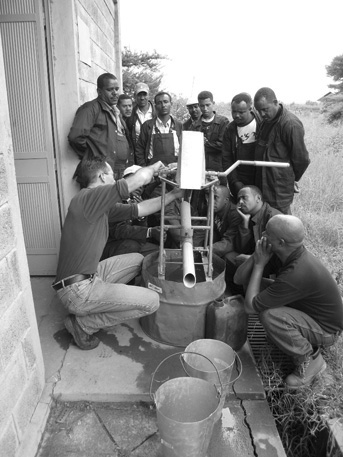Japan's Official Development Assistance White Paper 2010
(3) Water and Sanitation
Water and sanitation are serious issues that concern all people’s lives. Approximately 884 million people worldwide in 2008 had no access to safe drinking water, including piped water or wells, and approximately 2.6 billion people around the world have no access to basic sanitation facilities such as sewage systems (Note 15). Lack of safe water and basic sanitation facilities cause diarrhea, and more than 1.5 million children under five years old lose their lives annually (Note 16).
<Japan’s Efforts>
At the Fourth World Water Forum in 2006, Japan announced the Water and Sanitation Broad Partnership Initiative (WASABI). Japan has the largest aid disbursements in the water and sanitation sector in the world, and provides comprehensive support for both ”soft” and ”hard” aspects by utilizing its wealth of experience, knowledge, and technology concerning this sector. Such support includes promotion of integrated water resource management, provision of safe drinking water and sanitation support, water use for promotion of increasing food production, water pollution prevention and ecosystem conservation, and mitigating damage from water-related disasters. At the Fourth Tokyo International Conference on African Development (TICAD IV) in May 2008, Japan announced support measures such as the fostering of human resources related to the development of water supply and sanitation facilities and water resource management. It also announced the dispatch of the Water Security Action Team (W-SAT). Moreover, Japan took up the water and sanitation issue for the first time in about five years at the G8 Hokkaido Toyako Summit in July 2008. It affirms the importance of circulatory water cycle management, and facilitates the sustainable use of water resources by promoting it.

Development of rope pump water supply technology in Ethiopia (Photo: JICA)
●Papua New Guinea: Port Moresby Sewerage System Upgrading Project
The coastal area of Port Moresby, the capital of Papua New Guinea, has no sewage treatment plant. For this reason, collected sewage is discharged to the coast without appropriate treatment, and is causing water contamination in the coastal area as well as the deterioration of the hygienic environment of the local residents. Through ODA loans of approximately ¥8.3 billion, Japan provides support to develop the sewerage system in order to improve the provision of sewerage services to the area and prevent the discharge of contaminated water to the coastal waters. This project is expected to contribute to improving the living environment of the residents, as well as promoting the conservation of the marine environment and the economic development of the area. In response to a request from the Government of Papua New Guinea, the project will utilize Japan’s advanced energy-saving technologies and know-how to operate the sewage treatment plant.
●Zambia: Sustainable Operation & Maintenance Project for Rural Water Supply (SOMAP) Phase 2
Even in rural areas where there is access to safe drinking water from wells and hand pumps, a broken pump may be left unrepaired if repair parts cannot be obtained. Japan aims to establish a sustainable operation and management system spearheaded by residents and local authorities. To this end, Japan will build a sales network of repair parts, as well as implement awareness raising campaigns for pump-users and repairmen training (Note 17).
Notes:
(15) Source: WHO/UNICEF, Progress on Sanitation and Drinking-water: 2010 Update, 2010.
(16) ddUNICEF, Progress for Children: A Report Card on Water and Sanitation, 2006.
(17) Phase 1 was completed in 2007. The project is currently in phase 2.
